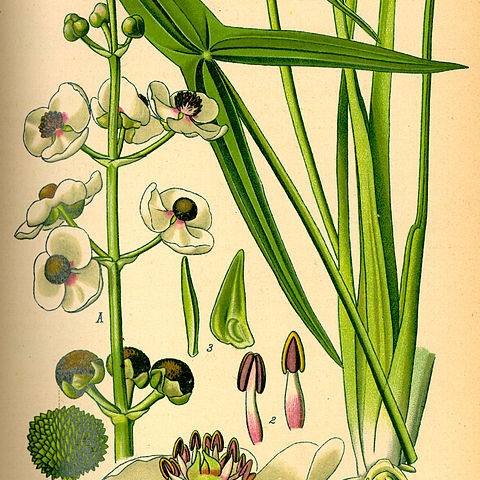Plants monoecious, perennial or rarely annual, glabrous to sparsely pubescent, growing submersed, floating-leaved, or emerged in fresh or brackish waters. Roots septate. Stems often with rhizomes; rhizomes occasionally terminated by tubers, tubers brown, smooth Leaves submersed, floating, or emerged, sessile or petiolate, petioles terete to triangular, blades present or absent, linear to rhombiform to sagittate, without pellucid markings. Inflorescences erect, racemose or paniculate scapes, emerged or floating, rarely submersed, whorls 1-17, each whorl with 2-3 flowers; bracts coarse or delicate, smooth to papillose, obtuse to acute; pedicels elongating after anthesis, ascending to recurved; carpellate flowers in lower part of inflorescences, staminate flowers above. Flowers unisexual, rarely lower ones with a ring of sterile stamens, pedicellate; sepals herbaceous to coriaceous, often sculptured, reflexed in staminate flowers, reflexed to appressed in carpellate flowers; petals white or rarely with a pink to purple spot or tinge; stamens 7-many, filaments linear to dilated, glabrous to pubescent, anthers basifixed, linear to orbicular; gynoecium of many carpels, carpels 1-ovuled, styles terminal. Achenes compressed, with a conspicuous dorsal wing, not ribbed, glandular.
Fls unisexual (the plants monoecious or rarely dioecious) or some of them perfect; receptacle large, convex; sep 3, reflexed in fr or persistently erect or spreading; pet 3, deciduous, white; stamens 7–many; pistils numerous, aggregated into a subglobose head on a large receptacle, appearing to be spirally arranged; achenes flattened, winged at least on the margins; infl racemose, with 1–12 mostly 3-fld whorls, each whorl subtended by 3 bracts, occasionally with floriferous branches substituting for fls at the lowest whorl(s), or the fl solitary and terminal in depauperate plants; rooted annual or perennial aquatics, the infl and usually also the lvs emersed; rhizomes sometimes with apical tubers. The lvs are all basal, typically with an aerial, expanded, often sagittate blade on a petiole about as long as the water is deep. In deep or swiftly moving water, wholly submersed lvs are produced by some spp.; these often take the form of ribbon-like bladeless phyllodia (the flattened petioles). Similar short, stiff phyllodia are produced in tidal sites. 25+, cosmop., mainly New World. (Lophotocarpus)
Emerged leaves sagittate or lanceolate, floating ones mostly cordate, submerged phyllodes linear. Inflorescence mostly a raceme with 1-14 mostly 3-flowered whorls, each sustained by a whorl of 3, more or less connate bracts, sometimes a panicle. Flowers mostly unisexual: upper ones male, lower ones female or ☿. Pedicels erect or ascending, those of female flowers often thickened and reflexed after anthesis. Sepals reflexed in male flowers, in female flowers appressed, patent, or reflexed. Petals delicate, white or rarely pink, sometimes with purple spot at the base. Stamens 1-∞; filaments filiform, subulate, or dilated. Carpels ∞, spirally arranged in a head on a large, globular receptacle. Style terminal, erect or obliquely directed inward. Achenes laterally compressed, beaked, winged, mostly membranous. Seed horseshoe-shaped.
Emergent aquatic, rhizomatous perennials or rarely annual, with submerged, emergent or floating leaves, sometimes producing tubers; most species monoecious. Inflorescence mostly erect with 1–numerous, 3-flowered whorls, bracteate. Flowers mostly unisexual, pedicellate; female flowers in lower whorls, occasionally with ring of functional or non-functional stamens, the fruiting pedicels sometimes thickened and recurved or reflexed; male flowers in upper whorls. Sepals 3, reflexed in male flowers. Petals 3, usually white, sometimes with purple spot at base. Stamens 6–numerous, whorled. Carpels numerous, in several whorls, apparently spirally inserted on swollen, globose or oblong receptacle. Fruit an aggregate of achenes; achenes laterally compressed, beaked, winged or wingless, rarely with spines (if present
Herbs, aquatic, often stoloniferous and tuberiferous. Leaves aerial, floating, or submerged, linear, lanceolate, deeply cordate, or sagittate. Inflorescences usually of 3-flowered whorls each with 3 bracts. Flowers unisexual or polygamous, upper ones male, with longer and slender pedicels, lower ones female or bisexual, with shorter and thickened pedicel. Stamens (6-)9 to numerous. Carpels numerous, spirally arranged, each with 1 ovule; styles apical or subadaxial. Achenes laterally compressed, margins usually winged, with an apical or lateral stylar beak.
Perennial, acaulescent, marsh or aquatic herbs with thickened fleshy rhizomes. Leaves erect or floating, sagittate or attenuated at the base, the submerged frequently without blades. Inflorescences simple or branched, bearing numerous whorls of 3 flowers, the lower usually pistillate and the upper usually staminate; sepals 3, green; petals 3, white.

